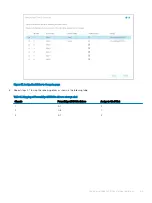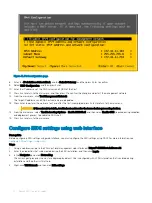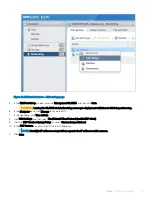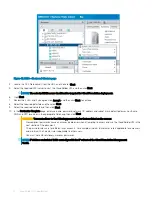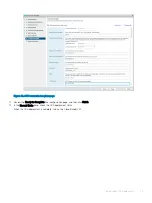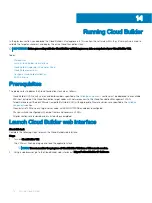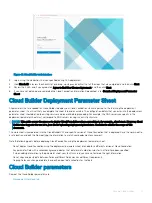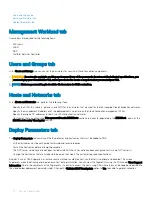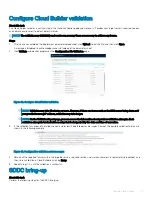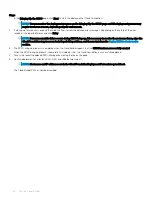
•
•
•
Management Workload tab
License keys are required for the following items:
•
ESXi hosts
•
vSAN
•
NSX
•
Platform Services Controller
Users and Groups tab
In the
Users and Groups
tab, you can set the passwords for your initial Cloud Foundation components.
CAUTION:
Do not make a mistake on this page because if any of the passwords do not meet the indicated specifications, you
must redeploy your Cloud Builder VM, unless you elected to create a snapshot after you created your VM.
NOTE:
Minimum password length should be 12 characters for NSX controllers.
Hosts and Networks tab
In the
Hosts and Networks
tab, perform the following steps:
•
Specify the VLAN IDs, subnets, gateways, and MTU for the networks that are used for the four required Cloud Foundation networks.
•
Specify the management IP addresses of the deployed hosts which are on the Cloud Foundation management VLAN.
•
Specify the range of IP addresses for both the vSAN and vMotion networks.
•
Host names that you enter in the
Management Domain ESXi Hosts
section are also auto-populated in the
ESXi Host
column of the
ESXi Host Security Thumbprint
section.
Deploy Parameters tab
The
Deploy Parameters
tab contains all the IP addresses and hostnames that must be added to DNS.
•
All the hostnames must be configured for forward and reverse lookups.
•
Test all the hostnames before attempting validation.
•
The NTP server would have already been tested as the ESXi hosts have already been configured to this same NTP server(s).
•
Change the hostnames that are listed and the domain that meets the customer required specifications.
By default, use of DSA fingerprints as a more secure method to validate a host’s authenticity is optional and disabled. The unique
fingerprints are automatically generated on each host during installation. You can view the fingerprints using the DCUI under
View Support
Information
. Due to the complexity of the fingerprints, it is easier to access the hosts using SSH where they can be copied and pasted into
the cloud builder deployment parameter sheet. Change the
Validate ESXi Thumbprints
option to
Yes
to enable fingerprint validation.
78
Running Cloud Builder
Summary of Contents for PowerEdge MX7000
Page 1: ...Dell EMC VMware Cloud Foundation for PowerEdge MX7000 Deployment Guide ...
Page 8: ...Figure 1 Cloud Foundation deployment workflow 8 Overview ...
Page 27: ...Figure 19 Dual PowerEdge MX7000 enclosure configuration Physical layout 27 ...
Page 29: ...Figure 20 MX9002m Management module cabling Physical layout 29 ...
Page 30: ...Figure 21 Connectivity between FSE modules and FEM modules 30 Physical layout ...
Page 31: ...Figure 22 Uplinks to customer network environment Physical layout 31 ...
Page 42: ...Figure 25 MX9002m Management Module cabling 42 Networking requirements ...
Page 43: ...Figure 26 Connectivity between FSE modules and FEM modules Networking requirements 43 ...
Page 44: ...Figure 27 Uplinks to customer network environment 44 Networking requirements ...


